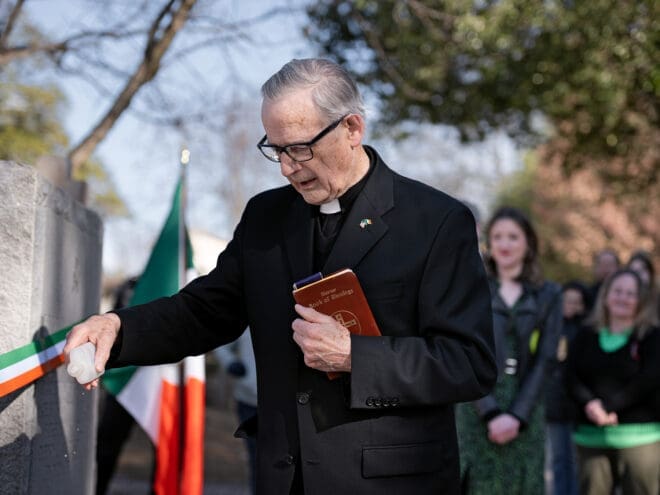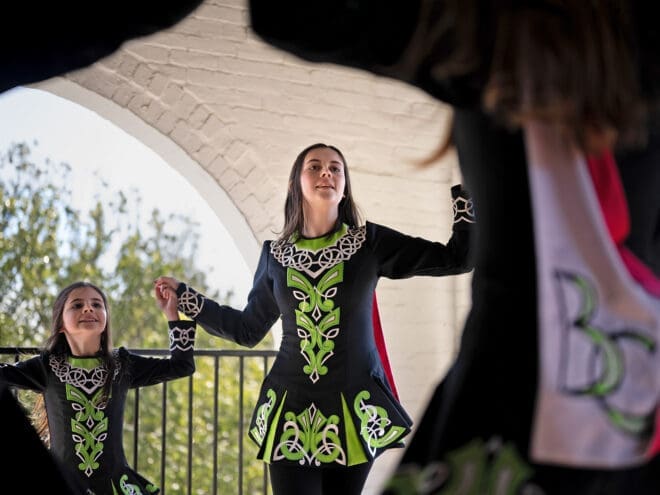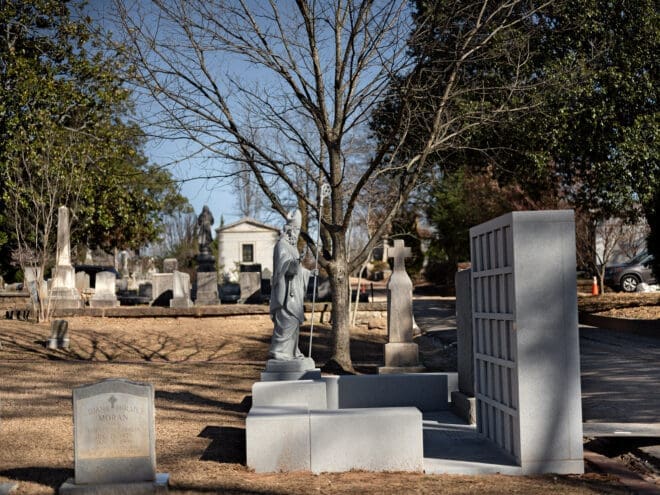 Photo by Johnathon Kelso
Photo by Johnathon KelsoAtlanta
A rededication to Irish history at Oakland Cemetery
By ANDREW NELSON, Staff Writer | Published March 8, 2024
ATLANTA—In 1873, the city of Atlanta gifted a parcel of land in its city cemetery to the Hibernian Benevolent Society as a final resting place for its poorer members.
In a leopard print coat, Robin Nunan watched a recent rededication ceremony, knowing her great, great-grandfather played a part in establishing the historic site 150 years earlier.
Her relative, Thomas Nunan, was the secretary for the civic organization for many years, stepping down in 1895. Her genealogy research uncovered her relative, a Union soldier attached to a cavalry unit from Ohio who settled here after the war. For a time, he had a vegetable stand and later worked with the railroad.
“I love history because I feel it’s a way to connect with people from the past,” said Nunan, an artist and teacher in Athens. “It’s a way to draw this line or a string that connects me to him. I was very excited to be able to belong to something that he was a part of. It’s like a continuity.”

Father John Kieran, chaplain of the Hibernian Benevolent Society, sprinkles holy water near the statue in honor of St. Patrick at Oakland Cemetery. Photo by Johnathon Kelso
With a large statue of St. Patrick, the society celebrated and rededicated a new landmark at its parcel. It is one of the most prominent statues that remembers Irish influence in Atlanta.
The Irish were one of the early immigrant groups to settle in Atlanta, drawn in part by construction of the railroad. The Hibernian Benevolent Society remains, with some 100 members. It is credited as the oldest civic association in Atlanta, founded in 1858.
“I feel very proud that an Irish man, Father O’Reilly, made such an impact,” Donal Fleming said. A 30-year resident of the Atlanta area, Fleming leads the society. He said natives of the country of “saints and scholars” are glad to have shaped Georgia history. “And I feel the Irish are still making an impact. There’s a lot of Irish companies operating from here.”
Father Thomas O’Reilly is credited for his actions during the Civil War during the occupation of Atlanta. The 33-year-old pastor at what is now the Shrine of the Immaculate Conception persuaded Union generals not to burn downtown civic and church buildings or risk a mutiny. Immaculate Conception Church, St. Philip’s Episcopal, Second Baptist, Central Presbyterian and Trinity Methodist as well as the Court House and City Hall were preserved. A statue honoring him stands near City Hall and he is buried in the church’s crypt.

Traditional Irish dancers perform at Oakland Cemetery during a Feb. 18 event hosted by the Hibernian Benevolent Society to rededicate its plot. Photo by Johnathon Kelso
“It continues the history of Irish people in Atlanta and many of us are very proud of that. I myself have been in Atlanta for 56 and a half years,” said Father John Kieran, chaplain to the organization.
Father Kieran grew up in a small town about 50 miles north of Dublin. He was one of some 40 priests from Ireland who were recruited to serve here during the 1960s when vocations were flush in Ireland and American priests in Georgia were few.
“I mean, people ask, why did I come here? Because I was invited to come and help serve the church here, so I volunteered,” he said.
The Hibernian Benevolent Society plot, which measures roughly 60 by 40 feet, is dotted with a dozen grave markers. However, the organization has learned there are only about a dozen spaces available to its members remaining.
St. Patrick overlooks the newly designed space. There are pavers with names of donors. In addition, there are two dozen niches for cremains. The society raised some $70,000 for the stonework and fundraising is still underway.

The Hibernian Benevolent Society section of Oakland Cemetery was recently redesigned. Photo by Johnathon Kelso
“We would like people to use it as an alcove for rest and reflection. If you’re out for a walk in Oakland, just come in, have a sit and think and reflect,” Fleming said.
Oakland Cemetery, with its 48 acres, has been undergoing restoration within the original six acres boundaries, the Bell Tower Ridge and East Hill areas. Richard Harker, the executive director of Historic Oakland Foundation, accepted a $3,000 check from the society.
The efforts of the Hibernians are part of what makes Oakland Cemetery special by revealing and sharing a little-known layer of the city’s history, said Harker.
“The history of the Hibernians and the Irish in Atlanta is so rich and so deep and has so many interesting tentacles that sort of spread out through all of Atlanta society that it’s really exciting for us to be able to add that layer into all of the way that we talk about Atlanta history,” he said.